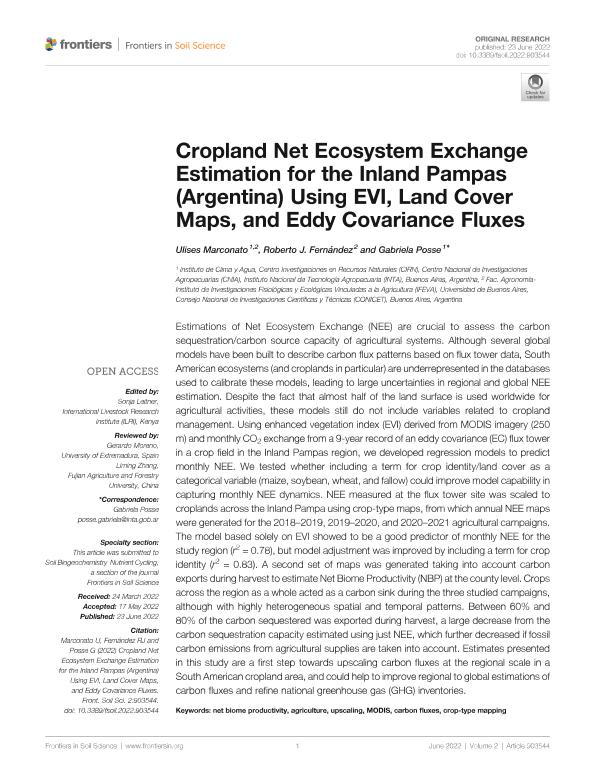Mostrar el registro sencillo del ítem
dc.contributor.author
Marconato, Ulises Mariano

dc.contributor.author
Fernandez, Roberto Julio

dc.contributor.author
Posse, Gabriela
dc.date.available
2023-06-29T12:25:29Z
dc.date.issued
2022-06
dc.identifier.citation
Marconato, Ulises Mariano; Fernandez, Roberto Julio; Posse, Gabriela; Cropland Net Ecosystem Exchange Estimation for the Inland Pampas (Argentina) Using EVI, Land Cover Maps, and Eddy Covariance Fluxes; Frontiers Media; Frontiers in Soil Science; 2; 6-2022; 1-12
dc.identifier.issn
2673-8619
dc.identifier.uri
http://hdl.handle.net/11336/201781
dc.description.abstract
Estimations of Net Ecosystem Exchange (NEE) are crucial to assess the carbon sequestration/carbon source capacity of agricultural systems. Although several global models have been built to describe carbon flux patterns based on flux tower data, South American ecosystems (and croplands in particular) are underrepresented in the databases used to calibrate these models, leading to large uncertainties in regional and global NEE estimation. Despite the fact that almost half of the land surface is used worldwide for agricultural activities, these models still do not include variables related to cropland management. Using enhanced vegetation index (EVI) derived from MODIS imagery (250 m) and monthly CO2 exchange from a 9-year record of an eddy covariance (EC) flux tower in a crop field in the Inland Pampas region, we developed regression models to predict monthly NEE. We tested whether including a term for crop identity/land cover as a categorical variable (maize, soybean, wheat, and fallow) could improve model capability in capturing monthly NEE dynamics. NEE measured at the flux tower site was scaled to croplands across the Inland Pampa using crop-type maps, from which annual NEE maps were generated for the 2018–2019, 2019–2020, and 2020–2021 agricultural campaigns. The model based solely on EVI showed to be a good predictor of monthly NEE for the study region (r2 = 0.78), but model adjustment was improved by including a term for crop identity (r2 = 0.83). A second set of maps was generated taking into account carbon exports during harvest to estimate Net Biome Productivity (NBP) at the county level. Crops across the region as a whole acted as a carbon sink during the three studied campaigns, although with highly heterogeneous spatial and temporal patterns. Between 60% and 80% of the carbon sequestered was exported during harvest, a large decrease from the carbon sequestration capacity estimated using just NEE, which further decreased if fossil carbon emissions from agricultural supplies are taken into account. Estimates presented in this study are a first step towards upscaling carbon fluxes at the regional scale in a South American cropland area, and could help to improve regional to global estimations of carbon fluxes and refine national greenhouse gas (GHG) inventories.
dc.format
application/pdf
dc.language.iso
eng
dc.publisher
Frontiers Media

dc.rights
info:eu-repo/semantics/openAccess
dc.rights.uri
https://creativecommons.org/licenses/by-nc-sa/2.5/ar/
dc.subject
NET BIOME PRODUCTIVITY
dc.subject
MODIS
dc.subject
UPSCALING
dc.subject
CARBON FLUXES
dc.subject.classification
Ciencias Medioambientales

dc.subject.classification
Ciencias de la Tierra y relacionadas con el Medio Ambiente

dc.subject.classification
CIENCIAS NATURALES Y EXACTAS

dc.title
Cropland Net Ecosystem Exchange Estimation for the Inland Pampas (Argentina) Using EVI, Land Cover Maps, and Eddy Covariance Fluxes
dc.type
info:eu-repo/semantics/article
dc.type
info:ar-repo/semantics/artículo
dc.type
info:eu-repo/semantics/publishedVersion
dc.date.updated
2023-06-28T13:31:35Z
dc.journal.volume
2
dc.journal.pagination
1-12
dc.journal.pais
Suiza

dc.description.fil
Fil: Marconato, Ulises Mariano. Instituto Nacional de Tecnología Agropecuaria. Centro de Investigación de Recursos Naturales. Instituto de Clima y Agua; Argentina. Consejo Nacional de Investigaciones Científicas y Técnicas. Oficina de Coordinación Administrativa Parque Centenario. Instituto de Investigaciones Fisiológicas y Ecológicas Vinculadas a la Agricultura. Universidad de Buenos Aires. Facultad de Agronomía. Instituto de Investigaciones Fisiológicas y Ecológicas Vinculadas a la Agricultura; Argentina
dc.description.fil
Fil: Fernandez, Roberto Julio. Consejo Nacional de Investigaciones Científicas y Técnicas. Oficina de Coordinación Administrativa Parque Centenario. Instituto de Investigaciones Fisiológicas y Ecológicas Vinculadas a la Agricultura. Universidad de Buenos Aires. Facultad de Agronomía. Instituto de Investigaciones Fisiológicas y Ecológicas Vinculadas a la Agricultura; Argentina
dc.description.fil
Fil: Posse, Gabriela. Instituto Nacional de Tecnología Agropecuaria. Centro de Investigación de Recursos Naturales. Instituto de Clima y Agua; Argentina
dc.journal.title
Frontiers in Soil Science
dc.relation.alternativeid
info:eu-repo/semantics/altIdentifier/url/https://www.frontiersin.org/articles/10.3389/fsoil.2022.903544/full
dc.relation.alternativeid
info:eu-repo/semantics/altIdentifier/doi/http://dx.doi.org/10.3389/fsoil.2022.903544
Archivos asociados
